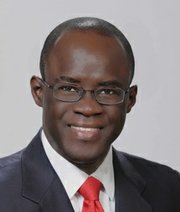Friday, February 15, 2019
By NEIL HARTNELL
Tribune Business Editor
nhartnell@tribunemedia.net
The government’s priority with Bank of The Bahamas (BOB) must be to “sell, sell, sell”, a prominent minority shareholder argued yesterday, despite half-year net income increasing by 164 percent.
Darron Cash, the former Free National Movement (FNM) chairman, told Tribune Business that the government’s divestment of its 82.6 percent equity interest was the only way to “inspire long-term, sustainable confidence” in the BISX-listed institution and protect Bahamian taxpayers from any future multi-million dollar bail-outs.
He added that BOB was “digging itself out of such a deep financial hole” that the $300m-plus of taxpayer monies used by successive governments to bail it out will never be recovered.
The only way to prevent similar losses in the future, he argued, was to get the government and politically-led decision-making out of BOB’s board and management, and place it in private sector hands.
Mr Cash spoke out after BOB unveiled a much-improved performance for the six months to end-December 2018, with net income more than doubling to $3.83m compared to just $1.451m in the prior year.
The enhanced bottom line was driven by a 35.9 percent reduction in provisions for non-performing loans, which fell by over $1m to $2.111m as opposed to the $3.292m incurred in the same period during 2017.
BOB also benefited from a significant drop in operating expenses, which fell by $1.3m or 8.77 percent year-over-year, hitting $13.537m compared to $14.839m for the 2017 half-year.
Kenrick Braithwaite, BOB’s managing director, not surprisingly used the improved results – coming after “five years of consecutive losses” - to strike an upbeat note by lauding the impact of the bank’s “transformation” and the start of a search for “more sustainable growth the opportunities”.
However, a more detailed analysis of BOB’s half-year results shows it still has much work to do, and a long road to travel, before it can claim “mission accomplished” on its recovery and begin to think about resuming dividend payments to shareholders.
For BOB’s first-half profits increase was driven entirely by reduced costs and lower loan loss provisions. Total operating income fell by $0.1m, or 0.53 percent, for the first six months, while top-line interest income declined by $1m year-over-year.
This shows revenues are declining, not falling, and Mr Braithwaite in his update to shareholders admitted the interest income, net interest income and operating income drop was “due to an overall decline in the performing loans portfolio”.
BOB’s net loan portfolio continues to decline, falling by almost $25m during the six months to end-December 2018 to close the period at $326.581m.
This means that it is struggling to find new, sustainable lending opportunities to generate income – the “bread and butter” of any commercial bank. And this is despite BOB possessing $618.222m in deposits, almost double its net loan book.
And, despite two bail-outs and the removal of bad loans worth an inflated $267.6m (based on gross book value’), BOB’s financials show that non-performing credit – loans that are more than 90 days’ past due – account for almost 30 percent of its $327m net loan book.
Non-performing loans rose from 28.92 percent at end-June 2018 to 29.77 percent at year-end, a ratio that is easily more than double the Bahamian commercial banking industry average.
And, without the $167.6m worth of government bonds injected into its balance sheet in the last bail-out, BOB would be insolvent with liabilities exceeding assets. A $137.276m accumulated deficit is also on the books.
“I continue to have a fair degree of confidence that the directors are taking the necessary steps to move the bank in the right direction,” Mr Cash told Tribune Business upon being informed of the results. “That is very encouraging.
“But the hole Bank of The Bahamas is climbing out of is so deep that, in my mind, the only appropriate course the bank ought to be taking is a policy decision and that means the Government of The Bahamas ought to be looking very aggressively at divesting itself from the bank.”
He added: “The absence of government control will be the only factor that instills long-term confidence in the bank.
“While the management and directors deserve credit for moving the bank forward, getting the Government out of the bank and its ability to take policy decisions will be the only thing that inspires long-term, sustainable confidence.”
The Government holds its 82.6 percent BOB stake through a combination of the Public Treasury and National Insurance Board (NIB), and multiple entities – both Bahamian and international – are understood have looked at a potential acquisition over the years but none has materialized.
“The Government has to acknowledge that the Bahamian people will never be made whole for what was pumped into BOB,” Mr Cash told Tribune Business.
“All the Bahamian people can count on the Government to do is cut its losses and minimize the potential for some government in the future that, in the interests of protecting the financial system, has no choice but to bail out BOB.
“Sell, sell, sell is the message we ought to be hearing from the Government right now.”
Mr Cash said BOB had “lost so many good people over the last several years, but at least it’s started to make some of the decisions to right the ship”.
He added: “There is always going to be the lingering doubt, or suspicion, that in the interests of saving face or saving someone’s credibility, that the Bahamian people have not been given the full story [on BOB]. Sell, sell, sell is the story.”
Mr Braithwaite, in his message to shareholders, added: “The bank’s total equity closed at $159.9m, lower than the June 30, 2018, balance of $177.8m due to the $4.7m charge against retained earnings for the implementation of IFRS 9 effective July 1, 2018, redemption of the remaining outstanding preference shares of $15.2m, and preference shares dividends payment of $1.5m, partially offset by the $3.8m net income for the six-month period ended December 31, 2018.”
